Accurate temperature recording is essential for successful handcrafted soap batches. Use reliable thermometers like Type T thermocouples or infrared readers to monitor critical points: oils at 120-130°F, lye solutions cooling to 120-130°F, and maintaining temperatures within 10°F of each other during mixing. Keep detailed logs of each measurement using templates that track initial temperatures, final readings, and room conditions. Proper documentation will help you identify patterns and troubleshoot quality issues in future productions.
Precise Temperature Recording Guide For Hand-Crafted Batches
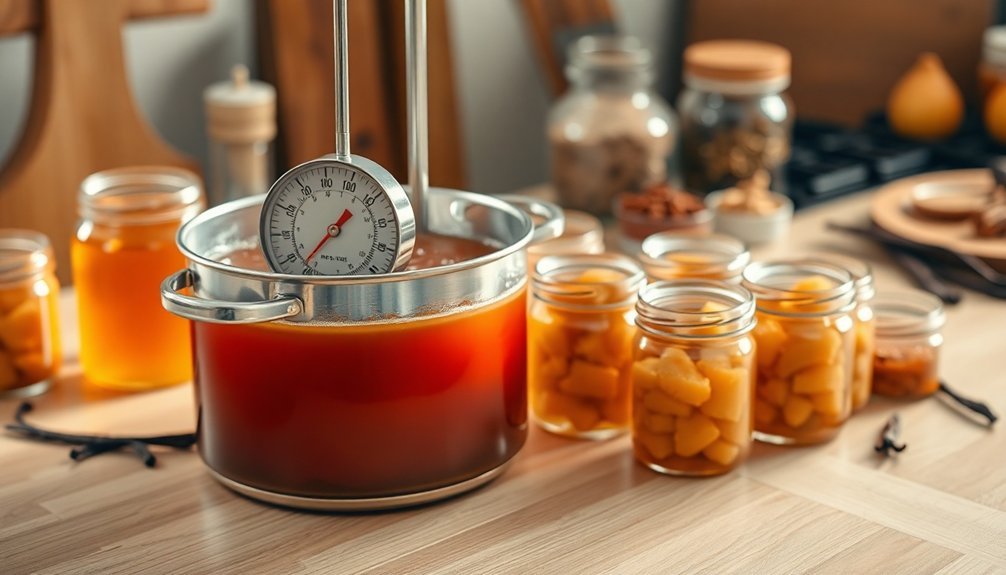
While maintaining quality across hand-crafted batches presents unique challenges, precise temperature recording offers the solution you need for consistent results.
By implementing data loggers with Type T or Type K thermocouples, you'll identify hot and cold spots that could compromise your products.
Start by placing thermal probes strategically throughout your oven to monitor both surface and air temperatures.
Software like SquirrelView allows easy setup and thorough data analysis, helping you optimize curing times while preventing undercured or overcooked batches. Utilizing the integrated non-volatile memory ensures your valuable temperature data remains intact even during unexpected power failures.
For small-scale operations, compact digital recorders like the Eurotherm nanodac provide professional-grade monitoring without extensive infrastructure.
You'll save energy and reduce costs by fine-tuning your process based on accurate temperature profiles, while generating compliance documentation that validates your quality standards.
Essential Equipment for Accurate Soap Temperature Monitoring
Accurate soap temperature monitoring builds upon the precision techniques used in hand-crafted batches.
You'll need reliable thermometers that accurately measure within the soap-making range (room temperature to 125°F). Infrared thermometers offer quick readings from -58°F to 716°F, while digital thermometers provide precision critical for quality control.
Your equipment should include heat-resistant containers for handling exothermic lye reactions, with stainless steel or heavy-duty plastic mixing bowls that resist caustic ingredients.
Pair these with silicone spatulas and non-reactive utensils to prevent unwanted chemical reactions.
Don't forget proper record-keeping tools to track temperature data throughout the process. Documenting temperatures in real-time recording ensures accuracy and helps maintain product consistency across batches.
Digital storage systems and batch records help maintain consistency across production runs, while data loggers can continuously monitor temperature changes during critical phases of soap making.
Setting Up Your Temperature Data Logging System
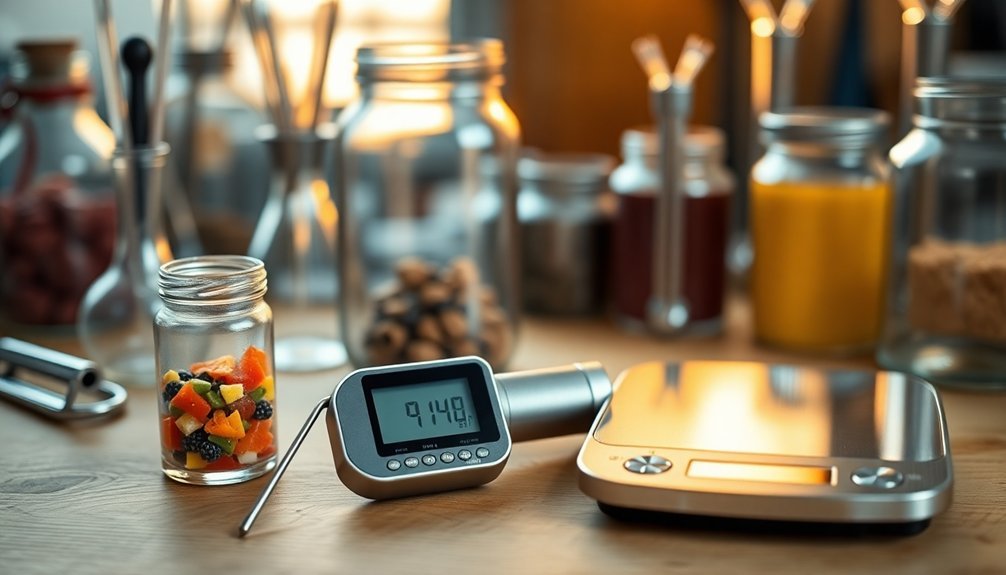
Setting up an effective temperature data logging system requires three key components working in harmony. You'll need properly configured hardware, optimized software, and strategic operational planning to guarantee accurate soap temperature monitoring. Ensure your sensors can effectively measure in the 10-40°C range for optimal batch monitoring.
| Component | Key Elements | Implementation Tips |
|---|---|---|
| Hardware | Arduino Leonardo Pro Micro, DS18B20 sensors | Use 1m cables for flexibility in sensor placement |
| Software | Arduino IDE, OneWire library | Modify library to use internal pull-ups for sensors |
| Data Storage | SD card (FAT32 format) | Structure logs as CSV files with timestamps |
| Monitoring | Real-time visualization with Python | Implement PyQt5 and matplotlib for live data |
Configure your system to log temperatures every 15 minutes for consistent tracking. You can retrieve data by simply transferring CSV files from the SD card to your computer for analysis or cloud storage.
Critical Temperature Points in the Saponification Process
Understanding the critical temperature points throughout the saponification process is vital for successful soap production.
You'll want to maintain your oil mixture between 120°F and 130°F to guarantee complete melting and prevent cloudiness that indicates unmelted hard oils or butters.
For your lye solution, prepare it 1-3 hours before soaping to allow cooling to 120-130°F.
Keep oil and lye mixtures within 10°F of each other to prevent oil solidification when mixed.
Temperature harmony matters! Maintain oils and lye within 10°F range to ensure smooth blending without unwanted solidification.
If you're making milk soap or working with sensitive ingredients, you'll need cooler temperatures to prevent scorching.
During saponification, cold process typically occurs between 80.6°F and 113°F, while hot process requires higher temperatures (140-160°C).
For complex designs like swirls or layers, use cooler lye to extend working time.
Temperature control during curing is equally important as it affects how quickly your soap will harden and cure properly for optimal quality.
Calibrating Your Thermometers for Consistent Results
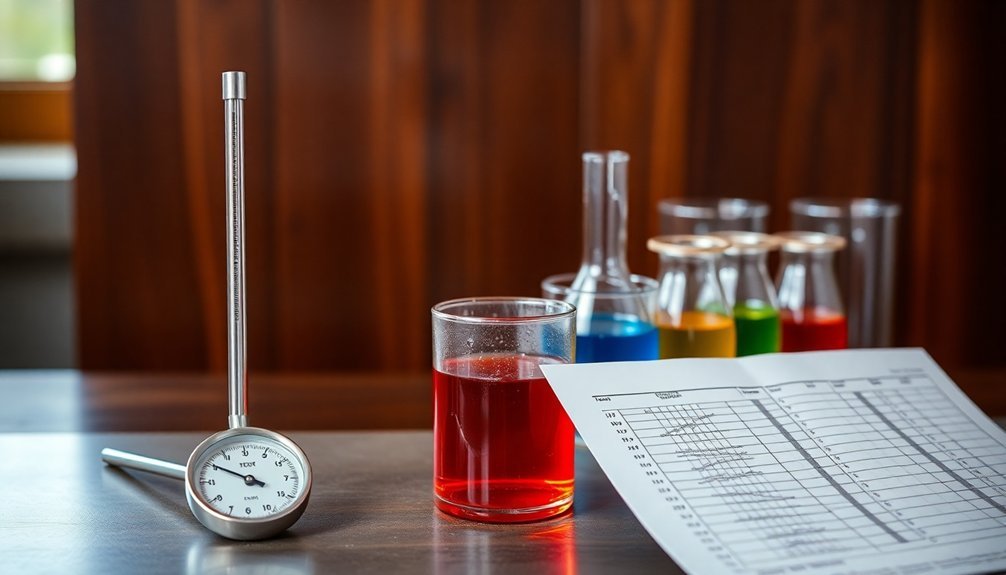
Two essential calibration methods—ice water and boiling water—will guarantee your thermometers provide reliable readings for soap making.
For ice water calibration, fill a glass with ice and water, insert the probe without touching sides or bottom, wait 15-30 seconds, then adjust to 32°F using the calibration nut.
For boiling water calibration, bring water to a rolling boil, considering your elevation's effect on boiling point. Insert the thermometer, wait for stabilization, then adjust to 212°F (at sea level).
Digital thermometers offer faster readings but can't typically be calibrated—only verified. For food applications, these thermometers provide readings in just 2-10 seconds.
Clean your thermometer after each use with soap and water, followed by sanitization. Remember to calibrate daily or after any drops or twists for accuracy within ±2°F.
Creating Effective Temperature Recording Templates
Now that your thermometers are properly calibrated, you'll need a system to consistently track temperature data throughout your soap-making process.
Design templates that capture essential temperature points while remaining practical enough for daily use. Your templates should strike a balance between thorough data collection and ease of implementation.
Key elements to include in your temperature recording templates:
- Dedicated fields for initial and final temperatures of both oils and lye solutions
- Space to note room temperature and environmental conditions that might affect your batch
- Timestamp columns to track temperature changes during critical process phases
- Section for recording thermometer calibration dates to guarantee accuracy
- Area for documenting any temperature-based adjustments made during production
Consider monitoring closely for false trace when working with recipes that contain hard oils that solidify at cooler temperatures.
Review and refine your templates regularly based on actual usage patterns and production needs.
Analyzing Temperature Data to Improve Soap Quality
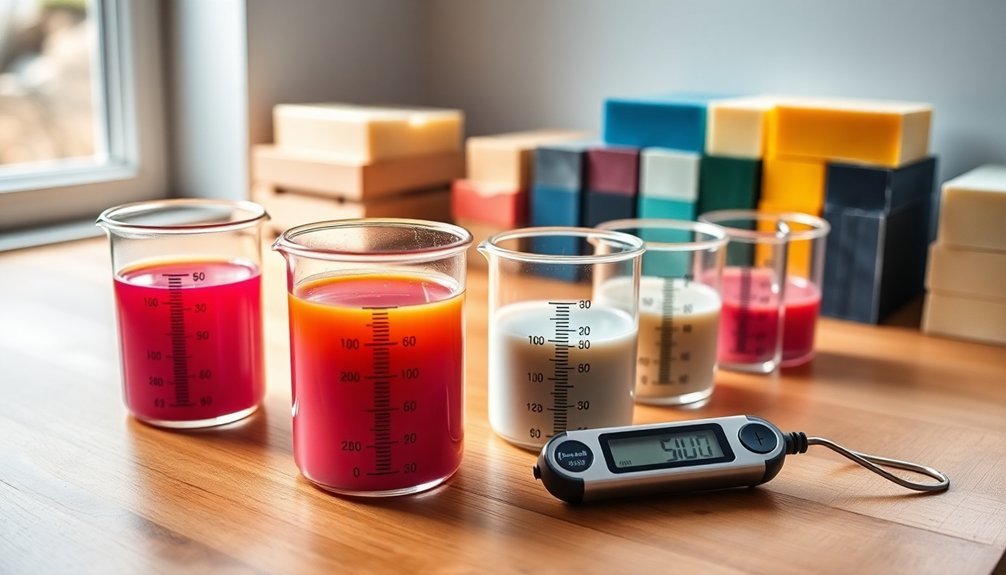
Once you've collected thorough temperature data from your soap-making process, you'll need systematic analysis methods to translate this information into quality improvements. Focus on identifying patterns between temperature variations and final soap characteristics.
| Temperature Issue | Quality Impact |
|---|---|
| High lye temps (>45°C) | Accelerated trace, potential separation |
| Low oil temps (<30°C) | False trace, uneven saponification |
| Inconsistent curing temps | Irregular moisture content, warping |
| Temperature spikes during mixing | Overheating, discoloration |
| Cold spots during pour | Partial gel phase, mottled appearance |
Compare your temperature logs against known ideal ranges (35-40°C). When you notice defects like excessive softness or poor lather, check your records for temperature deviations. Implementing corrective measures based on your analysis will greatly enhance batch consistency and overall soap quality.
Frequently Asked Questions
Can Temperature Fluctuations Affect Soap Scent Retention?
Yes, temperature fluctuations greatly impact your soap's scent retention. When you expose soaps to high heat, fragrance molecules evaporate faster. You'll preserve scents longer by controlling temperatures during both making and storage processes.
How Does Humidity Impact Temperature Readings During Saponification?
Humidity impacts your temperature readings by causing measuring devices to show inaccurate values. High humidity can slow heat dissipation during saponification, while condensation on instruments may lead to false readings you'll need to compensate for.
Are Wireless Temperature Loggers Reliable for Small-Batch Soap Making?
Yes, wireless temperature loggers are reliable for small-batch soap making. They'll give you accurate readings within ±0.4°C, send alerts if temperatures deviate, and allow you to monitor batches remotely without constant supervision.
What Temperature Recording Frequency Is Ideal for Hand-Crafted Batches?
For hand-crafted batches, you'll need to record temperatures at critical control points: during mixing, after heating, and at cooling intervals. Record every 5-15 minutes during processing and hourly during storage or curing.
How Do Different Oils Influence Optimal Temperature Ranges?
Different oils dictate your temperature ranges based on their smoke points. You'll need lower heat for butter (300-350°F) and olive oil (325-410°F), while avocado oil lets you work at much higher temperatures (up to 570°F).
In Summary
You've now mastered the art of temperature recording for your handcrafted soap batches. By using properly calibrated equipment, maintaining detailed logs, and analyzing your temperature data, you'll consistently create higher quality products. Don't underestimate how these precise measurements can transform your soap-making process. Remember, what you can measure accurately, you can improve reliably. Your attention to temperature detail will become your competitive advantage.

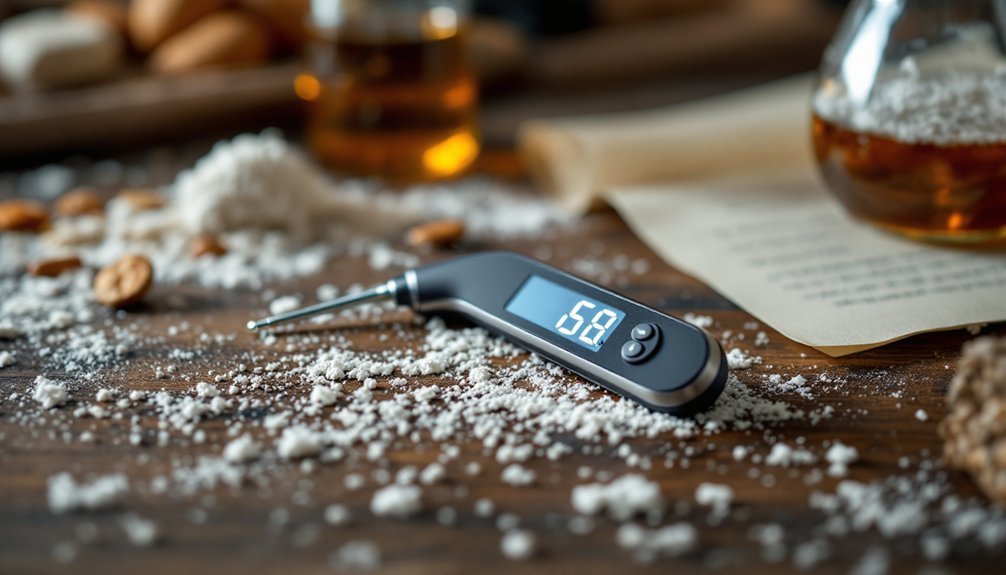



Leave a Reply